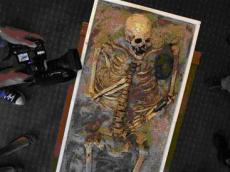|
|
TODAY.AZ / Weird / Interesting
Bulgaria's museum to show "vampire" skeleton
18 June 2012 [13:55] - TODAY.AZ
 Bulgaria's history museum plans to display a "vampire" skeleton next week after unearthing the 700-year-old remains of two men stabbed through the chest with iron rods.
Bulgaria's history museum plans to display a "vampire" skeleton next week after unearthing the 700-year-old remains of two men stabbed through the chest with iron rods.Archaeologists, excavating a monastery near the Black Sea city of Sozopol, discovered the skeletons which were buried in a pagan ritual that they said was aimed at keeping the men from turning into vampires.
"This was a pagan belief widespread in the Bulgarian lands in the 12th to 14th centuries. People were very superstitious then," National History Museum head Bozhidar Dimitrov said.
"Throughout the country we have found over 100 such 'vampire' burials of mainly noblemen from the Middle Ages who were branded bloodsucking immortals."
Dimitrov explained that these people were considered bad during their lifetime and according to pagan beliefs could become vampires after death and continue to torment the living.
"That's why they were often pierced with rods, wooden or metal," he said.
The Balkan country, which remained pagan until it embraced Christianity in the ninth century, borders Romania -- birthplace of the 15th century ruler often associated with the popular fictional character upon which Dracula is based.
Romania's notorious 15th century ruler Vlad Tepes, or Vlad the Impaler was no vampire, but his cruelty and name inspired the fictional Dracula created by novelist Bram Stoker.
The finds in Bulgaria have sparked interest from vampire enthusiasts all over the world and the small Balkan country may seek to capitalize on its pagan heritage.
/Reuters/
URL: http://www.today.az/news/interesting/108898.html
 Print version
Print version
Views: 2296
Connect with us. Get latest news and updates.
See Also
- 19 February 2025 [22:20]
Visa and Mastercard can return to Russia, but with restrictions - 05 February 2025 [19:41]
Japan plans to negotiate with Trump to increase LNG imports from United States - 23 January 2025 [23:20]
Dubai once again named cleanest city in the world - 06 December 2024 [22:20]
Are scented candles harmful to health? - 23 November 2024 [14:11]
Magnitude 4.5 earthquake hits Azerbaijan's Lachin - 20 November 2024 [23:30]
Launch vehicle with prototype of Starship made its sixth test flight - 27 October 2024 [09:00]
Fuel prices expected to rise in Sweden - 24 October 2024 [19:14]
Turkiye strikes terror targets in Iraq and Syria - 23 October 2024 [23:46]
Kazakhstan supplied almost entire volume of oil planned for 2024 to Germany in 9 months - 23 October 2024 [22:17]
Taiwan reported passage of Chinese Navy aircraft carrier near island
Most Popular
 The inconvenient truth: who actually owns the road through Meghri
The inconvenient truth: who actually owns the road through Meghri
 Azerbaijan observes Lawyers' Professional Day
Azerbaijan observes Lawyers' Professional Day
 Jubilee event marking 75th anniversary of Professor Ibadulla Aghayev held in Baku
Jubilee event marking 75th anniversary of Professor Ibadulla Aghayev held in Baku
 Kevin Durant scores 30 points to lead Rockets to dominant win over Cavaliers
Kevin Durant scores 30 points to lead Rockets to dominant win over Cavaliers
 Capacity building in assistive technology supports inclusive health [INTERVIEW]
Capacity building in assistive technology supports inclusive health [INTERVIEW]
 World Azerbaijanis Solidarity Day celebrated in Tashkent
World Azerbaijanis Solidarity Day celebrated in Tashkent
 Test of time: Karabakh showed who came to create
Test of time: Karabakh showed who came to create
